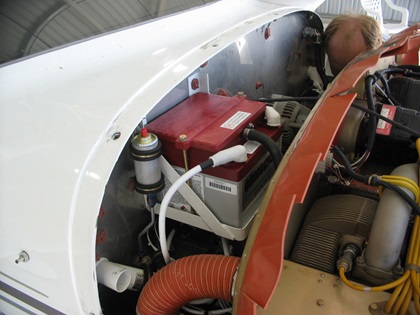Aircraft Maintenance: Never jump-start a dead battery
The pilot arrived at the airport ready to fly home after having been away for the weekend seeing a child off to college. While performing the preflight, he noticed that the stall warning wasn’t sounding. The source of the problem was obvious as soon as he looked at the instrument panel: The master switch had been left on…for two full days.
The battery was so depleted that it was impossible to sound the stall warning or even engage the master solenoid. Anxious to get home and knowing that it would be challenging to get help on a Sunday, the pilot began to rationalize shortcuts to get home quickly. With VFR conditions forecast for the duration of the flight home, he thought that the risks of jump-starting the airplane and flying home were minimal. At his request, the ground crew at the FBO brought over a tug and hooked it up to the external power plug on the airplane. At first, there wasn’t even enough power to move the propeller, and so they revved the engine of the tug and waited a bit. Finally, the dead battery and the tug produced enough power between them to drive the starter, turn the prop, and get the engine started. The cart disconnected, and the pilot let the airplane idle and assessed the situation. The ammeter was showing a very strong charge as the alternator fed the battery, but all seemed well otherwise, so he took off for home.
According to Chris Holder, Eastern U.S. sales manager at Concorde Battery, the only safe way to proceed is by following the structured approach of evaluating and charging the battery as detailed in the battery maintenance manual. That begins by measuring the open circuit voltage (OCV) of the battery. For Concorde’s RG Series of batteries, an OCV at or above 12.5 volts, but below 12.75 volts, for a 12-volt battery (25.0 – 25.5 volts for a 24-volt battery) means that the battery requires a constant voltage charging procedure (per the manual) before use. That process takes at least three hours, and could be much longer depending on the amount of discharge. For batteries with an OCV below 12.5 volts for a 12-volt battery (25 volts for a 24-volt battery), the battery must go through a special charging and capacity test procedure detailed in the Concorde maintenance manual to determine if it is airworthy.

As a matter of fact, if a battery’s OCV is below 9 volts (18 volts for a 24-volt battery), it is likely permanently damaged. As batteries get to this state of “deep discharge,” the internal cells can reverse polarity and become unrecoverable.
Aircraft battery design is a balancing act between weight, power capacity, and durability. Beyond starting the engine, the primary function of the battery is to provide a reserve of electrical power in case the alternator fails, allowing pilots to navigate, communicate, and get the aircraft back on the ground safely. In order to do this, it must be airworthy before flight. It’s a recipe for disaster to assume that the alternator will charge the battery during flight.
In this particular case, the alternator and voltage regulator most likely struggled to work with a severely depleted battery. As the regulator tried to keep up and maintain bus voltage, the voltage may have spiked and tripped the voltage regulator’s over-voltage cutoff, sending the alternator offline. The same voltage spike likely took out the alternator-out warning module, which was found to be internally shorted, causing the smell of something burning in the cockpit until its own power fuse blew.
The pressure to get home can be significant. The best way to protect yourself when you’re stranded away from home and feeling that pressure is to reach out to someone else for advice. Take a moment to phone a friend, call your mechanic, or reach out to a service such as Savvy Maintenance’s breakdown assistance service. Cooler heads always make better decisions. Until next time, I hope you and your families remain safe and healthy, and I wish you blue skies.



